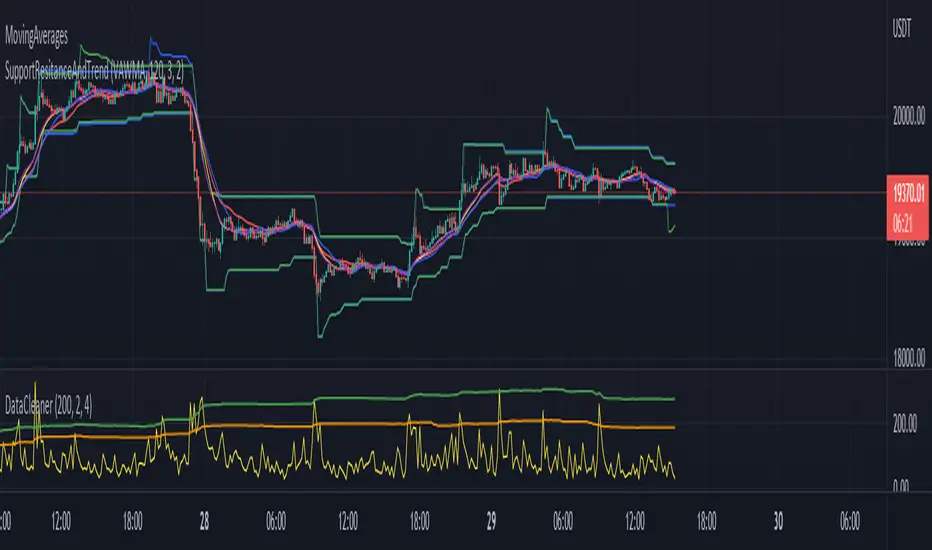PINE LIBRARY
MovingAverages

Library "MovingAverages"
vawma(len, src, volumeDefault)
VAWMA = VWMA and WMA combined. Simply put, this attempts to determine the average price per share over time weighted heavier for recent values. Uses a triangular algorithm to taper off values in the past (same as WMA does).
Parameters:
len: The number of bars to measure with.
src: The series to measure from. Default is 'hlc3'.
volumeDefault: The default value to use when a chart has no (N/A) volume.
Returns: The volume adjusted triangular weighted moving average of the series.
cma(n, D, C, compound)
Coefficient Moving Avereage (CMA) is a variation of a moving average that can simulate SMA or WMA with the advantage of previous data.
Parameters:
n: The number of bars to measure with.
D: The series to measure from. Default is 'close'.
C: The coefficient to use when averaging. 0 behaves like SMA, 1 behaves like WMA.
compound: When true (default is false) will use a compounding method for weighting the average.
ema(len, src)
Same as ta.ema(src,len) but properly ignores NA values.
Parameters:
len: The number of samples to derive the average from.
src: The series to measure from. Default is 'close'.
wma(len, src, startingWeight)
Same as ta.wma(src,len) but properly ignores NA values.
Parameters:
len: The number of samples to derive the average from.
src: The series to measure from. Default is 'close'.
startingWeight: The weight to begin with when calculating the average. Higher numbers will decrease the bias.
vwma(len, src, volumeDefault)
Same as ta.vwma(src,len) but properly ignores NA values.
Parameters:
len: The number of bars to measure with.
src: The series to measure from. Default is 'hlc3'.
volumeDefault: The default value to use when a chart has no (N/A) volume.
get(type, len, src)
Generates a moving average based upon a 'type'.
Parameters:
type: The type of moving average to generate. Values allowed are: SMA, EMA, WMA, VWMA and VAWMA.
len: The number of bars to measure with.
src: The series to measure from. Default is 'close'.
Returns: The moving average series requested.
vawma(len, src, volumeDefault)
VAWMA = VWMA and WMA combined. Simply put, this attempts to determine the average price per share over time weighted heavier for recent values. Uses a triangular algorithm to taper off values in the past (same as WMA does).
Parameters:
len: The number of bars to measure with.
src: The series to measure from. Default is 'hlc3'.
volumeDefault: The default value to use when a chart has no (N/A) volume.
Returns: The volume adjusted triangular weighted moving average of the series.
cma(n, D, C, compound)
Coefficient Moving Avereage (CMA) is a variation of a moving average that can simulate SMA or WMA with the advantage of previous data.
Parameters:
n: The number of bars to measure with.
D: The series to measure from. Default is 'close'.
C: The coefficient to use when averaging. 0 behaves like SMA, 1 behaves like WMA.
compound: When true (default is false) will use a compounding method for weighting the average.
ema(len, src)
Same as ta.ema(src,len) but properly ignores NA values.
Parameters:
len: The number of samples to derive the average from.
src: The series to measure from. Default is 'close'.
wma(len, src, startingWeight)
Same as ta.wma(src,len) but properly ignores NA values.
Parameters:
len: The number of samples to derive the average from.
src: The series to measure from. Default is 'close'.
startingWeight: The weight to begin with when calculating the average. Higher numbers will decrease the bias.
vwma(len, src, volumeDefault)
Same as ta.vwma(src,len) but properly ignores NA values.
Parameters:
len: The number of bars to measure with.
src: The series to measure from. Default is 'hlc3'.
volumeDefault: The default value to use when a chart has no (N/A) volume.
get(type, len, src)
Generates a moving average based upon a 'type'.
Parameters:
type: The type of moving average to generate. Values allowed are: SMA, EMA, WMA, VWMA and VAWMA.
len: The number of bars to measure with.
src: The series to measure from. Default is 'close'.
Returns: The moving average series requested.
Biblioteka Pine
W zgodzie z duchem TradingView autor opublikował ten kod Pine jako bibliotekę open-source, aby inni programiści Pine z naszej społeczności mogli go ponownie wykorzystać. Ukłony dla autora. Można korzystać z tej biblioteki prywatnie lub w innych publikacjach open-source, jednak ponowne wykorzystanie tego kodu w publikacjach podlega Zasadom serwisu.
Wyłączenie odpowiedzialności
Informacje i publikacje nie stanowią i nie powinny być traktowane jako porady finansowe, inwestycyjne, tradingowe ani jakiekolwiek inne rekomendacje dostarczane lub zatwierdzone przez TradingView. Więcej informacji znajduje się w Warunkach użytkowania.
Biblioteka Pine
W zgodzie z duchem TradingView autor opublikował ten kod Pine jako bibliotekę open-source, aby inni programiści Pine z naszej społeczności mogli go ponownie wykorzystać. Ukłony dla autora. Można korzystać z tej biblioteki prywatnie lub w innych publikacjach open-source, jednak ponowne wykorzystanie tego kodu w publikacjach podlega Zasadom serwisu.
Wyłączenie odpowiedzialności
Informacje i publikacje nie stanowią i nie powinny być traktowane jako porady finansowe, inwestycyjne, tradingowe ani jakiekolwiek inne rekomendacje dostarczane lub zatwierdzone przez TradingView. Więcej informacji znajduje się w Warunkach użytkowania.